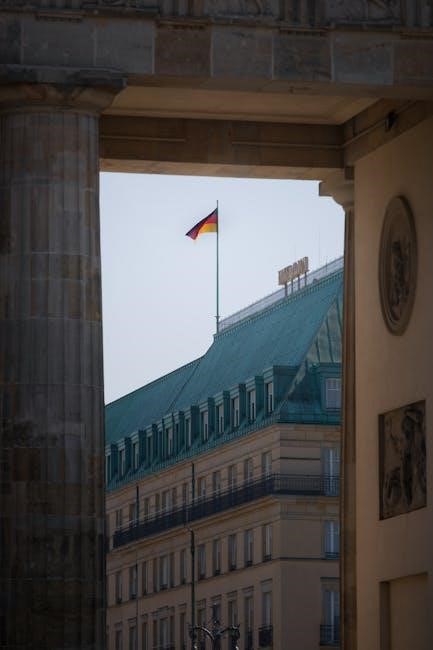The 1973 Petrodollar Agreement established a strategic partnership between the US and Saudi Arabia‚ linking global oil prices to the US dollar‚ reinforcing its dominance in international trade.
1.1 Historical Context of the 1973 Agreement
The 1973 Petrodollar Agreement emerged amid global economic turmoil. The collapse of the Bretton Woods system in 1971 left the US dollar without a gold anchor‚ creating financial instability. Meanwhile‚ the 1973 Arab-Israeli War triggered an oil embargo by Arab nations‚ leading to soaring oil prices. Saudi Arabia‚ as the world’s largest oil exporter‚ gained significant leverage. The agreement was forged to stabilize the dollar by tying oil sales to US currency‚ ensuring America’s economic dominance while securing Saudi Arabia’s geopolitical interests through US military protection.
1.2 Key Players: United States and Saudi Arabia
The US sought to maintain its economic influence post-Bretton Woods‚ while Saudi Arabia aimed to secure its oil exports and regional stability. The agreement was facilitated by Secretary of State Henry Kissinger‚ who negotiated with Saudi officials. The partnership ensured the US dollar’s dominance in global trade‚ while Saudi Arabia gained military protection and economic ties. This collaboration solidified both nations’ roles as central players in global energy markets and geopolitics‚ shaping a decades-long alliance that continues to influence international relations and economic structures.

Background and Preconditions for the Agreement
The 1973 Petrodollar Agreement emerged amid the collapse of the Bretton Woods system and the 1973 Oil Crisis‚ creating a need for economic and geopolitical stability.
2.1 The Collapse of the Bretton Woods System
The Bretton Woods System‚ established in 1944‚ collapsed in 1971 when the US ended the gold-backed dollar‚ leading to floating exchange rates and economic instability. This collapse created a void in global monetary stability‚ prompting the US to seek new mechanisms to maintain the dollar’s dominance. The end of the gold standard exposed the dollar’s vulnerability‚ driving the need for alternative strategies to reinforce its global reserve currency status. This set the stage for the Petrodollar Agreement‚ which tied oil exports to the US dollar‚ ensuring its continued relevance in international trade and finance.
2.2 The 1973 Oil Crisis and Its Impact
The 1973 Oil Crisis emerged during the Yom Kippur War‚ as Arab oil producers embargoed exports to the US and its allies‚ leading to a sharp increase in global oil prices. This caused widespread economic disruption‚ including inflation‚ recessions‚ and energy shortages in affected nations. The crisis highlighted the vulnerability of oil-dependent economies and underscored the need for a stable monetary framework to manage global trade.
The embargo’s impact accelerated the search for a solution to stabilize oil markets and currency exchange‚ creating the urgency that led to the Petrodollar Agreement.

The Economic Implications of the Petrodollar Agreement
The Petrodollar Agreement significantly bolstered the US dollar’s global dominance‚ creating a cycle where oil sales fueled demand for dollars‚ stabilizing its value and reinforcing its role in international trade.
3.1 The Rise of the US Dollar as a Global Reserve Currency
The Petrodollar Agreement solidified the US dollar’s status as the global reserve currency by ensuring oil exports were priced in dollars. This created consistent demand for dollars worldwide‚ enhancing its stability and dominance in international transactions. Countries needed dollars to purchase oil‚ reinforcing the dollar’s central role in global trade and finance. The agreement effectively linked the dollar to the global energy economy‚ further cementing its position as the primary currency for international reserves and trade settlements.
3.2 The Role of Oil in Shaping Global Trade
The Petrodollar Agreement transformed oil into a strategic commodity‚ with its pricing in US dollars reshaping global trade dynamics. Oil-producing nations‚ led by Saudi Arabia‚ ensured consistent demand for dollars‚ stabilizing international markets. This system compelled countries to hold dollars for energy purchases‚ reinforcing dollar dominance. The agreement also tied global economic stability to energy markets‚ creating a powerful interdependence between oil and currency. This fiscal arrangement solidified oil’s central role in shaping global trade patterns and economic policies‚ making it a cornerstone of international commerce.

The Geopolitical Dynamics of the Agreement
The Petrodollar Agreement strengthened US-Saudi ties‚ ensuring US influence in the Middle East while securing Saudi Arabia’s stability through military protection‚ reshaping global power dynamics.
4.1 US-Saudi Arabia Partnership and Military Cooperation
The 1973 Petrodollar Agreement solidified a mutual benefit alliance between the US and Saudi Arabia. In exchange for pricing oil in US dollars‚ Saudi Arabia received robust military protection and political support‚ enhancing its regional security. This partnership not only bolstered the US’s strategic influence in the Middle East but also ensured the stability of global oil markets. The agreement marked the beginning of a long-standing collaboration‚ with the US providing advanced weaponry and training to Saudi forces‚ further cementing their alliance against common adversaries.
4.2 The Impact on the Middle East and Global Power Structures
The Petrodollar Agreement reshaped Middle Eastern geopolitics and global power dynamics. By aligning with the US‚ Saudi Arabia gained dominance in the region‚ while the US strengthened its influence. The agreement weakened other currencies and reinforced the dollar’s global supremacy. It also influenced conflicts‚ such as the Arab-Israeli dispute‚ and shifted alliances‚ with Egypt moving closer to the US. This realignment solidified the US’s position as a global hegemon and reshaped international relations‚ with Saudi Arabia emerging as a pivotal player in energy and geopolitics.

The Petrodollar System and Its Evolution
The Petrodollar System evolved from the 1973 agreement‚ ensuring oil pricing in US dollars‚ reinforcing global economic dominance and shaping energy trade dynamics worldwide.
5.1 The Mechanics of Pricing Oil in US Dollars
The 1973 Petrodollar Agreement established a system where Saudi Arabia priced oil exports exclusively in US dollars. This mechanism ensured that global oil transactions would demand dollars‚ reinforcing its status as the world’s reserve currency. The agreement tied oil‚ the most traded commodity‚ to the dollar‚ creating consistent demand and stabilizing its value. Saudi Arabia‚ as the swing producer‚ played a crucial role in maintaining price stability. This arrangement benefited both the US‚ by bolstering the dollar’s dominance‚ and Saudi Arabia‚ by securing military protection and economic influence. The system has endured‚ shaping global energy trade and financial markets.
5.2 The Role of Saudi Arabia as the Swing Producer
Saudi Arabia emerged as the swing producer under the Petrodollar Agreement‚ leveraging its vast oil reserves to control global supply and stabilize prices. By adjusting production‚ Saudi Arabia influenced oil markets‚ ensuring price stability and maintaining the value of the US dollar. This role solidified Saudi Arabia’s economic and geopolitical influence‚ while the US gained a strategic partner in securing energy markets. The arrangement reinforced mutual interests‚ with Saudi Arabia benefiting from military protection and the US strengthening the dollar’s global dominance.

Challenges and Critics of the Petrodollar System
The Petrodollar system faces criticism for fostering economic inequality‚ dependency on fossil fuels‚ and geopolitical tensions‚ with critics arguing it perpetuates instability and environmental degradation globally.
6.1 Economic Inequalities and Dependency on Fossil Fuels
The Petrodollar system has exacerbated economic inequalities by concentrating wealth in oil-exporting nations while burdening importers with high energy costs. This dependency on fossil fuels has hindered global efforts to transition to renewable energy‚ perpetuating environmental degradation and climate change. The system’s reliance on oil reinforces economic disparities‚ benefiting a few nations at the expense of others; Critics argue it fosters instability and limits sustainable development‚ highlighting the urgent need for diversification and energy independence to address these systemic imbalances and promote global economic equity.
6.2 Geopolitical Tensions and Competing Interests
The Petrodollar agreement has fueled geopolitical tensions‚ as it aligns Saudi Arabia closely with the US‚ straining relations with other oil producers like Iran and Iraq. This alliance has influenced regional conflicts‚ such as the Arab-Israeli dispute‚ and shaped global power dynamics. Competing interests from emerging economies and alternative payment systems threaten the Petrodollar’s dominance‚ creating instability in energy markets. These tensions highlight the delicate balance of power and the ongoing struggle for influence in global energy markets‚ driven by economic and political rivalries.

The Petrodollar Agreement and Contemporary Issues
The Petrodollar Agreement faces contemporary challenges‚ including the rise of alternative currencies‚ shifting global energy markets‚ and the growing influence of emerging economies in international trade.
7.1 The Rise of Alternative Currencies and Payment Systems
The rise of alternative currencies and payment systems‚ such as cryptocurrencies and central bank digital currencies‚ challenges the Petrodollar’s dominance. Cryptocurrencies like Bitcoin and Ethereum offer decentralized alternatives‚ reducing reliance on the US dollar for international transactions. Meanwhile‚ nations like China and India are developing their own digital currencies‚ potentially undermining the Petrodollar system. Additionally‚ initiatives like the Maastricht Circle aim to create a euro or yuan-based oil pricing mechanism‚ further diversifying global trade currencies and shifting economic power dynamics away from US dollar hegemony.
7.2 The Role of Emerging Economies in Challenging the Petrodollar
Emerging economies‚ particularly China and India‚ are playing a pivotal role in challenging the Petrodollar system. These nations are increasingly using their own currencies for oil transactions‚ reducing dollar dependency. China’s Belt and Road Initiative promotes yuan-denominated oil trade‚ while India explores rupee-based payments. Such moves aim to diversify global trade currencies and diminish US influence; These efforts‚ combined with regional cooperation‚ signal a shift toward a multipolar economic order‚ potentially eroding the Petrodollar’s longstanding dominance in international energy markets and global finance.
The Future of the Petrodollar System
The Petrodollar system faces challenges from renewable energy growth and digital currencies‚ potentially weakening its dominance as global energy markets diversify and alternative payment systems emerge.
8.1 The Impact of Shifting Energy Markets and Renewable Energy
The rise of renewable energy and shifting global energy demands are challenging the Petrodollar system. As nations transition to solar‚ wind‚ and other sustainable sources‚ dependence on fossil fuels decreases‚ potentially reducing the strategic importance of oil and weakening the Petrodollar’s dominance. This shift could lead to diversification in energy trade currencies‚ threatening the US dollar’s supremacy. Meanwhile‚ major oil exporters like Saudi Arabia are exploring economic diversification to remain relevant in a post-oil era‚ signaling a gradual move away from sole reliance on hydrocarbons.
8.2 The Potential for a Post-Petrodollar World Order
A post-Petrodollar world could emerge as global energy transitions accelerate‚ reducing reliance on fossil fuels. The rise of renewable energy and digital currencies may erode the US dollar’s dominance‚ challenging the Petrodollar system. Nations like China and Russia are already exploring alternative payment systems for oil‚ potentially reshaping global economic power structures. This shift could diminish US influence and create a more multipolar world‚ where energy trade is no longer tethered to the dollar‚ fostering new alliances and economic paradigms in the 21st century.
The Petrodollar Agreement of 1973 reshaped global economics‚ linking oil prices to the US dollar and reinforcing its dominance. This partnership between the US and Saudi Arabia has had lasting geopolitical and economic impacts‚ shaping international relations and trade dynamics‚ while its relevance endures in the modern global economy.
9.1 The Legacy of the 1973 Petrodollar Agreement
The 1973 Petrodollar Agreement left an indelible mark on global economics by establishing the US dollar as the primary currency for oil transactions. This arrangement not only strengthened the dollar’s dominance but also solidified the US-Saudi partnership‚ reshaping geopolitical dynamics. The agreement ensured US influence in the Middle East while providing Saudi Arabia with military and economic stability. Its legacy continues to shape international trade‚ energy markets‚ and global power structures‚ underscoring its enduring significance in modern economic history.
9.2 Its Relevance in the Modern Global Economy
The Petrodollar Agreement remains pivotal in shaping today’s global economy‚ ensuring the US dollar’s dominance in international trade and energy markets. It maintains monetary stability‚ as oil‚ the world’s most traded commodity‚ is priced in dollars. This system compels nations to hold dollar reserves‚ reinforcing US economic influence. Despite emerging challenges from alternative currencies and shifting energy landscapes‚ the Petrodollar system continues to underpin global financial structures‚ highlighting its enduring relevance in modern economic dynamics.

